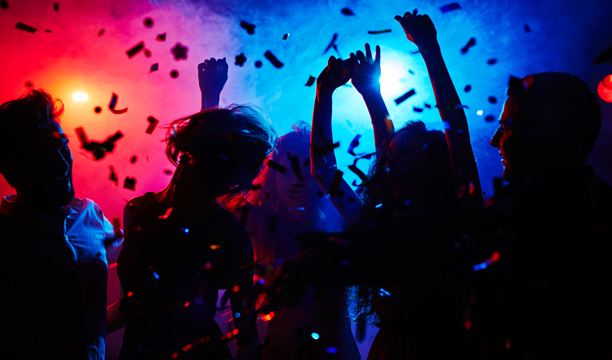The clubbing culture of India has transformed over the last 10 years. A decade ago, while the rich partied in clubs at five-star hotels, those lower on the wealth scale could choose from a few local pubs and bars.
Today, a new scene has emerged, with people moving to places that offer a blend of comfortable spaces for socializing, dining, drinking, and music as well as dancing.
This emerging sector, known as ‘pubs, bars, cafés & lounges (PBCL)’, courted a market share of Rs 10,480 crore in 2016. In 2021, this market share is expected to reach 16,880 crores, according to the National Restaurant Association of India (NRAI) report.
Where’s the party?
<div style="width:100%;height:0;padding-bottom:53%;position:relative;"><iframe src="https://giphy.com/embed/10hO3rDNqqg2Xe" width="100%" height="100%" style="position:absolute" frameBorder="0" class="giphy-embed" allowFullScreen></iframe></div><p><a href="https://giphy.com/gifs/carnaval-carnival-dance-10hO3rDNqqg2Xe">via GIPHY</a></p>
Currently, there are 40 to 50 PBCL players in India, with 250-277 outlets spread across different metropolitan cities. These include famous chains like The Beer Café, Social, TGI Friday, MyBar etc.
Their reach in smaller cities remains limited on account of hitches in license acquisition, and thus 91 percent of all such outlets are spread across metros and mini-metropolitan cities.
Western India, which includes places like Mumbai, Pune, Jaipur, and Goa, dominates India’s PBCL sector, accounting for 43 percent of such venues. The north, with Chandigarh and Delhi, among other places, has 32 percent of such joints, with the south accounting for 23 percent. The east, home to Kolkata, is still catching up, with just 2 percent of India’s PBCL outlets.
Clothing and after-hours
Along with the varying distribution, say the regulars, there is also a big difference in how different parts of the country party, including how safe patrons, as well as employees, feel staying out late.
Among regulars of the Indian nightlife scene, there is a broad consensus that Delhi is a wayward cousin to other cities that have a happening after-hours vibe.
Where the Delhi clubber is seen as one who flaunts his lavish tastes and walks around with a misplaced sense of entitlement, the south is said to have mastered the art of partying with respect and subtlety.
Many frequent party-goers say the culture in Bengaluru, which shares Delhi’s 1 am a curfew, is much more easy-going than the Capital. If you grew up in Bangalore, you grew up in a city that by default had a very chilled-out vibe.
But north India, especially Delhi-NCR, is notorious for brash behavior by club patrons. Also, with Delhi’s reputation for sexual misconduct and rape, women seldom feel safe on night-outs in the city.
Patrons who are regulars of the night scene in Delhi and Chennai also pointed out the clothing restrictions several joints in the Capital imposed.
In Delhi and Chandigarh, proper clothing is an unsaid requirement, with frequent stories of customers being turned away from nightclubs for attire deemed unbecoming.
The crowd
India has one of the youngest populations in the world — with an estimated 65 percent of its people aged below 35. This is the target audience for PBCLs, which are usually located in malls, high streets, popular markets, office complexes and even in airport hotels.
Many venues have begun diversifying as the programming on offer is usually what sets them apart like sports bars screening world cup matches are becoming popular, with many venues also hosting music gigs and stand-up comedy shows.
However, patrons agree that Delhi has led the way in fostering an atmosphere inclusive of the LGBTQ community.
In 2011, for example, young hotelier Keshav Suri redefined inclusivity in the industry with his luxurious nightclub Kitty Su in the five-star Hotel Lalit that was modeled after a drag queen. Kitty Su now has franchises in three other cities — Mumbai, Bengaluru, and Chandigarh.
What are the vices in this nightlife?
With so many people coming together under the influence of alcohol, things can get chaotic, which is why clubs are often reported as the hotbed of sexual harassment. Recent cases have included a man groping a woman, drinks allegedly being spiked with drugs and even murder.
A party crowd high on psychedelics dancing with abandon is not just an image; it is a reality; besides alcohol, psychedelics have emerged as essential for some party-goers.
Kolkata, on the other hand, is trying to tighten the security in clubs and pubs after a massive drug bust in the city in December 2017.
India is breaking boundaries and adopting from various Western cultures when it comes to partying but it faces the very serious risks it poses to the mental and physical health of those it involves.

